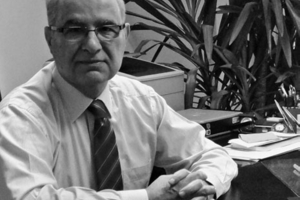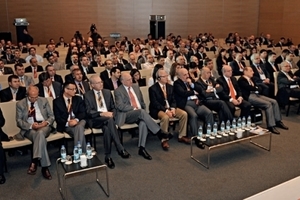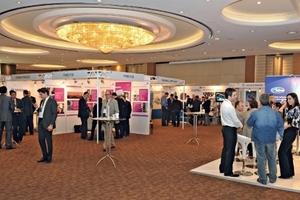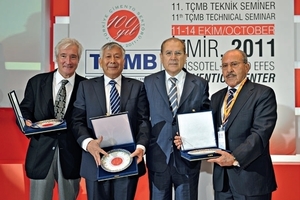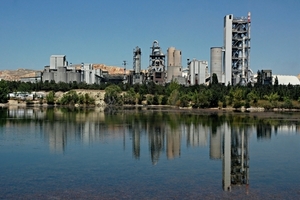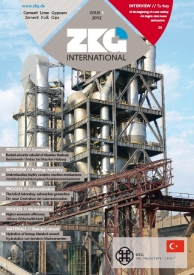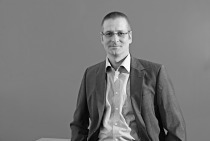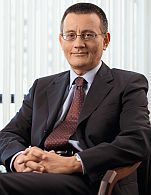At the beginning of a new century
The 2011 Turkish Cement Manufacturers’ Association (TÇMB) conference coinciding the 100th anniversary of the Turkish cement industry was held from 11.10.–13.10.2011 in Izmir/Turkey (Fig. 1). In a number of papers, all the current hot topics in the cement industry were covered. In a parallel exhibition all participants from cement plants and machinery suppliers had the possibility of networking and exchange of information (Fig. 2). A gala dinner rounded off the event. ZKG took the opportunity to interview Oğuz Tezmen, General Coordinator of TÇMB, about the conference and the present and future challenges for the Turkish cement industry.
ZKG: Mr. Tezmen, how was the response to your invitation to the seminar?
Oğuz Tezmen: We had a very good response to our conference in 2011. A total of more than 400 participants was recorded. About 143 Turkish cement producers participated. Before the TÇMB 2011 Technical Seminar, there had never been so many participants at any previous conference or seminar. 23 Turkish companies, 43 international companies participated together with their branch offices and representatives in Turkey.
ZKG: How did you select the topics for the conference?
Oğuz Tezmen: During the planning of the conference in 2011, we asked our member companies which topics should be covered in the conference program. This listing of interesting topics was merged with another list that we prepared which covered the topics we found to be interesting at an international level. This final list was then again discussed with the member companies to be sure to have a representative program that met both national and international demands. Accordingly, we received valuable contributions on the following main themes: “Energy efficiency and environment”, “Obtaining energy from waste heat” and “Waste and alternative fuels”. Both cement plant personnel and participants from machinery suppliers informed the audience about new cement types, new processing possibilities and up-to-date techniques for improvement of production and energy effiency.
ZKG: In 2011 you invited representatives from different associations all over the world (Fig. 3). What is the interest in cooperation with those associations, such as the Cembureau, AUCBM, Chinese Cement Association, NCB?
Oğuz Tezmen: We have the intention of building cooperation between the associations, mainly to share the latest developments and to get an insight into the existing situation and about technological improvements. More specifically, we want to initiate direct contact with them to benefit from the past experience of those associations, to organize regional joint symposiums and to develop an information exchange scheme. The final objective is to implement a strong collaboration on a global scale.
ZKG: Will you continue to organize international seminars in the future?
Oğuz Tezmen: The next conference, the 12th TÇMB Technical Seminar, will be held in 2013 as it is a biennial seminar. It will again be an international event, presumably with a high level of participation due to the relationships that have been built-up over years with the companies and with the support of the recognised international media and other international cement and building material association partners.
ZKG: Could you tell us about your views on the future development of the cement industry in Turkey?
Oğuz Tezmen: EU environment negotiations will certainly create a need for investment in this sector. We hope that acquis on EU Environmental legislation will be of great benefit to improve the quality of life of our people and to implement the development models compatible with the environment. Within the acquis period, Turkey is obliged to harmonize and implement all EU Environmental legislation. To comply with EU regulations, a substantial part of the legislation will have to be transposed into national law. Of course, these arrangements closely concern emissions and activities of the industrial sector.. In this process, making investments in technology, building new plants and establishing new treatment systems can be necessary in the industrial sector. Implementation of more binding environmental limit values will be considered. There will be new constraints on the execution of mining activities and rehabilitation of lands damaged by mining activities. The REACH regulations, i.e. the registration, evaluation and authorization of chemicals should be applied, to mention only some of the aspects.
ZKG: What are the preconditions to be met to achieve the corresponding alterations?
Oğuz Tezmen: Initially, financial resources and time are needed to adapt to the EU. According to the study of public institutions, investment of 12.6 billion € is envisaged to be in conformity with the Industrial Pollution Prevention Directive. The share of the cement industry in this investment will need to be a minimum of 2 billion € at least. Within the framework of the Kyoto Protocol, we have the public support that we require for the fulfilment of environmental responsibilities and for tackling climate change. We will continue to work with constructive and alternative methods for the future of the Turkish cement sector on issues such as the elimination of obstacles in the use of waste as fuel, preventing unqualified and non-standard ready-mixed concrete manufacture.
“Sustainable development” will be the main policy of the Turkish cement industry, also at the celebration of our second 100th anniversary. In the second century, we will continue respecting the environment and playing a more active role in technological developments and we will also increase our efforts to use less energy in production even more. In its second century, the cement industry will see an upgrade in “quality of life” as a priority.
ZKG: What are presently the most important key issues in the Turkish cement industry?
Oğuz Tezmen: The cement industry, the first industrial sector of our country and one of the most important leading forces for our development and growth, celebrates its 100th anniversary. For 100 years the cement industry has been working with the mission of “constructive life force”. The production capacity of the cement industry in Turkey was only 20 000 t in 1911. In the year of its 100th anniversary, it increased to over 66 million t and ranked first in Europe and the fourth in the world after China, India and USA. With a share of exports of 12 %, Turkey is in first place, leaving behind China and many countries in Eastern Asia. Today, the Turkish cement industry is a branch of industry that plays a crucial role in the Turkish economy with its approximately 4.5 billion US$ turnover, 1 billion US$ exports and direct employment for 15 000 people. It has an internationally accepted reputation for product quality; capacity, export potential, R&D centers established to sustain healthy development of the industry, training facilities, environmental awareness, human resources, occupational safety and health, and investments. In this way, the Turkish cement industry confidently sets forth its mission of “environmental, economic and social sustainability” to create more “value” for Turkey in the year of its 100th anniversary. The cement industry is growing in a sustainable way and with increasing environmental consciousness.
This important industrial branch has already taken the necessary precautions against possible damage to the environment. The production of the Turkish cement industry is in compliance with all national laws and regulations relating to the environment, in particular flue gas emissions, wastewater discharges, prevention of soil pollution, and minimization and disposal of wastes. Dust emissions are controlled by “flue gas dust collection systems”. SO2 emissions are controlled by neutralizing the sulphur content of the fuel used in the kiln with lime in the raw material. “Environmental Measurements” are carried out to secure emission permits. After receiving the permits, control measurements are carried out with continuous monitoring devices at the stacks. Independent accredited laboratories carry out all environmental measurements of the sector. Wastes are used as alternative raw material and alternative fuels after securing all relevant environmental permits. Thus, natural resources and conventional energy sources ( such as coal, petroleum coke, etc.) are saved. Unfortunately, we still have a very limited use of wastes in our country. The use of waste as alternative fuels is on average 30 % in Europe, whereas it is approximately 3 % in Turkey.
ZKG: What is the reason for the low proportion of secondary fuels? What has to be done to improve this?
Oğuz Tezmen: Although we have legislation on collection, classification and use of wastes, we could not achieve the desired level of waste supply and use of waste fuel. This is primarily due to the unclear definition of the responsibilities for the waste producers and due to inadequate control. Therefore, the use of industrial and municipal wastes like the waste oils widely used in cement production in EU countries and old vehicle tires as waste fuels in the cement industry should be provided for by the elimination of present deficiencies as soon as possible. The Turkish cement industry is ready to take part in the collective struggle for the reduction of greenhouse gas emissions. The measures for greenhouse gas reduction in the cement industry are limited to energy efficiency investments, production of blended cement and use of wastes as alternative fuel. Therefore, recently the Turkish cement industry focuses its energy on these subjects. Energy consumption values in the Turkish cement sector are lower than the average consumption values of the European Union because many of the plants have been built recently and/or modernized to an advanced level in recent years. As a result, the energy saving potential is very limited, especially at newly established plants.
The Ministry of Energy and Natural Resources, General Directorate of Electric Power Resources Survey and Development Administration has been collecting energy consumption values of the cement industry confidentially, evaluating and publishing coded comparison tables of the facilities until 2002. In light of these data, energy saving potential of cement production in Turkey has changed from 9 % to 5 % between 2005 and 2009. The ratio of electrical energy saving is only about 1 %. The Turkish cement sector grew up 3,6 % in cement production in the first nine months of 2011. 18 % of the cement produced during this period was channelled to the exports. Also, 12 % growth in domestic sales and 24 % decrease in exports were realized within this period.
ZKG: Many thanks for the interview.

